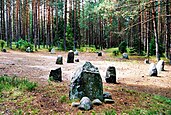Peoples belonging to numerous archaeological cultures identified with Celtic, Germanic and Baltic tribes, lived in various parts of what is now Poland in Antiquity – an era that dates from about 400 BC to AD 450–500. Many of them developed relatively advanced material culture and social organization, as evidenced by the archaeological record, such as the richly furnished dynastic princely graves. Some preserved written remarks by Roman authors that are relevant to the developments on Polish lands provide additional insight. Celtic peoples established a number of settlement centers, beginning in the early 4th century BC, mostly in southern Poland, which was at the outer edge of their expansion. Through their highly developed economy and crafts, they exerted lasting cultural influence (La Tène culture) disproportional to their small numbers in the region. Germanic peoples lived in today's Poland for several centuries (Wielbark culture). With the expansion of the Roman Empire, the Germanic tribes came under Roman cultural influence. As nomadic peoples invaded from the east, the Germanic people left for the safer and wealthier lands in southern and western Europe. The northeast corner of contemporary Poland's territory remained populated by Baltic tribes. (Full article...)
